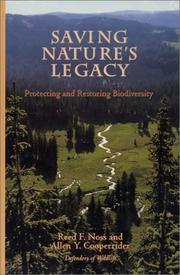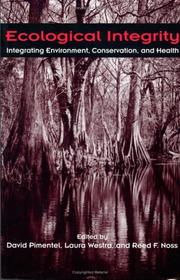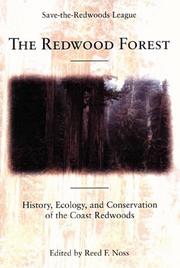| Listing 1 - 10 of 11 | << page >> |
Sort by
|
Book
ISBN: 159726489X 1597263621 161091225X Year: 2013 Publisher: Washington, DC : Island Press,
Abstract | Keywords | Export | Availability | Bookmark
 Loading...
Loading...Choose an application
- Reference Manager
- EndNote
- RefWorks (Direct export to RefWorks)
Forgotten Grasslands of the South is a literary and scientific case study of some of the biologically richest and most endangered ecosystems in North America. Eminent ecologist Reed Noss tells the story of how southern grasslands arose and persisted over time and addresses questions that are fundamental for conserving these vital yet poorly understood ecosystems. The author examines the natural history of southern grasslands their origin and history (geologic, vegetation, and human) biological hotspots and endangered ecosystems physical determinants of grassland distribution, including ecology, soils, landform, and hydrology fire, herbivores, and ecological interactions The final chapter presents a general conservation strategy for southern grasslands, including prioritization, protection, restoration, and management. Also included are examples of ongoing restoration projects, along with a prognosis for the future. In addition to offering fascinating new information about these little-studied ecosystems, Noss demonstrates how natural history is central to the practice of conservation. Natural history has been on a declining trajectory for decades, as theory and experimentation have dominated the field of ecology. Ecologists are coming to realize that these divergent approaches are in fact complementary, and that pursuing them together can bring greater knowledge and understanding of how the natural world works and how we can best conserve it. Forgotten Grasslands of the South explores the overarching importance of ecological processes in maintaining healthy ecosystems, and is the first book of its kind to apply natural history, in a modern, comprehensive sense, to the conservation of biodiversity across a broad region. It sets a new standard for scientific literature and is essential reading not only for those who study and work to conserve the grasslands of the South but also for everyone who is fascinated by the natural world.
Grassland conservation -- Southern States. --- Grassland ecology -- Southern States. --- Natural history -- Southern States. --- Earth & Environmental Sciences --- Environmental Sciences --- Natural history --- Grassland conservation --- Grassland ecology --- Grasslands --- Conservation of grasslands --- Grasslands conservation --- Ecology --- Conservation --- Environment. --- Ecology. --- Trees. --- Wildlife. --- Fish. --- Nature conservation. --- Environment, general. --- Nature Conservation. --- Fish & Wildlife Biology & Management. --- Terrestial Ecology. --- Tree Biology. --- Nature conservation --- Environmental sciences. --- Wildlife management. --- Balance of nature --- Biology --- Bionomics --- Ecological processes --- Ecological science --- Ecological sciences --- Environment --- Environmental biology --- Oecology --- Environmental sciences --- Population biology --- Animal populations --- Game management --- Management, Game --- Management, Wildlife --- Plant populations --- Wildlife resources --- Natural resources --- Wildlife conservation --- Conservation of nature --- Nature --- Nature protection --- Protection of nature --- Conservation of natural resources --- Applied ecology --- Conservation biology --- Endangered ecosystems --- Natural areas --- Dendrology --- Nursery stock --- Woody plants --- Arboriculture --- Forests and forestry --- Timber --- Environmental science --- Science --- Management --- Ecology . --- Fish --- Pisces --- Aquatic animals --- Vertebrates --- Fisheries --- Fishing --- Ichthyology
Article
Abstract | Keywords | Export | Availability | Bookmark
 Loading...
Loading...Choose an application
- Reference Manager
- EndNote
- RefWorks (Direct export to RefWorks)
Book
ISBN: 9780813052199 081305219X 9780813056715 0813056713 Year: 2018 Publisher: Gainesville
Abstract | Keywords | Export | Availability | Bookmark
 Loading...
Loading...Choose an application
- Reference Manager
- EndNote
- RefWorks (Direct export to RefWorks)
This book is the first to apply the new discipline of evolutionary fire ecology to a particular region: Florida and the southeastern coastal plain.
Forest fires --- Wildfires --- Fire ecology --- Ecopyrology --- Fires --- Fire --- Ecology --- Bush fires --- Bushfires --- Wild fires --- Wildland fires --- Natural disasters --- Deforestation --- Fire weather --- Environmental aspects
Digital
ISBN: 9781610912259 Year: 2013 Publisher: Washington, DC Island Press/Center for Resource Economics
Abstract | Keywords | Export | Availability | Bookmark
 Loading...
Loading...Choose an application
- Reference Manager
- EndNote
- RefWorks (Direct export to RefWorks)
Forgotten Grasslands of the South is a literary and scientific case study of some of the biologically richest and most endangered ecosystems in North America. Eminent ecologist Reed Noss tells the story of how southern grasslands arose and persisted over time and addresses questions that are fundamental for conserving these vital yet poorly understood ecosystems. The author examines the natural history of southern grasslands their origin and history (geologic, vegetation, and human) biological hotspots and endangered ecosystems physical determinants of grassland distribution, including ecology, soils, landform, and hydrology fire, herbivores, and ecological interactions The final chapter presents a general conservation strategy for southern grasslands, including prioritization, protection, restoration, and management. Also included are examples of ongoing restoration projects, along with a prognosis for the future. In addition to offering fascinating new information about these little-studied ecosystems, Noss demonstrates how natural history is central to the practice of conservation. Natural history has been on a declining trajectory for decades, as theory and experimentation have dominated the field of ecology. Ecologists are coming to realize that these divergent approaches are in fact complementary, and that pursuing them together can bring greater knowledge and understanding of how the natural world works and how we can best conserve it. Forgotten Grasslands of the South explores the overarching importance of ecological processes in maintaining healthy ecosystems, and is the first book of its kind to apply natural history, in a modern, comprehensive sense, to the conservation of biodiversity across a broad region. It sets a new standard for scientific literature and is essential reading not only for those who study and work to conserve the grasslands of the South but also for everyone who is fascinated by the natural world.
Nature protection --- General ecology and biosociology --- Botany --- Environmental protection. Environmental technology --- Pedology --- natuurbeheer --- milieukunde --- milieu --- ecologie --- natuurbescherming --- milieubeheer --- bomen

ISBN: 1559632488 Year: 1994 Publisher: Washington, D.C. Island Press
Abstract | Keywords | Export | Availability | Bookmark
 Loading...
Loading...Choose an application
- Reference Manager
- EndNote
- RefWorks (Direct export to RefWorks)
General ecology and biosociology --- Environmental protection. Environmental technology --- Biodiversiteit --- Biodiversity --- Biodiversité --- Biological diversification --- Biological diversity --- Biological diversity conservation --- Biologische verscheidenheid --- Biologische verscheidenheid--Instandhouding --- Biotic diversity --- Conservation of biological diversity --- Diversification [Biological ] --- Diversity [Biological ] --- Diversity [Biotic ] --- Diversité biologique --- Diversité biologique--Protection --- Ecosystem management --- Ecosystemen--Beheer --- Ecosystèmes--Gestion --- Maintenance of biological diversity --- Management of ecosystems --- Preservation of biological diversity --- Biodiversity conservation --- Biodiversity conservation. --- Biodiversity. --- Ecosystem management. --- Aménagement des écosystèmes --- Biotic communities -- Management --- Ecosystemen -- Beheer --- Ecosystems management --- Gestion des écosystèmes --- Écosystèmes -- Aménagement --- Écosystèmes -- Gestion --- United States --- Ecosystem management - United States.

ISBN: 1559638079 1559638087 9781559638074 9781559638081 1417543833 9781417543830 9781610910637 161091063X Year: 2000 Publisher: Washington, D.C. Island Press
Abstract | Keywords | Export | Availability | Bookmark
 Loading...
Loading...Choose an application
- Reference Manager
- EndNote
- RefWorks (Direct export to RefWorks)
Ecological integrity. --- Ecosystem integrity --- Integrity, Ecological --- Ecology

ISBN: 1610913388 9781610913386 1559637250 1559637269 Year: 2000 Publisher: Washington, D.C.
Abstract | Keywords | Export | Availability | Bookmark
 Loading...
Loading...Choose an application
- Reference Manager
- EndNote
- RefWorks (Direct export to RefWorks)
Coast redwood. --- Coast redwood --- Forest ecology. --- Ecology. --- Forest ecosystems --- Forests and forestry --- Ecology --- California redwood --- Californian redwood --- Coastal redwood --- Redwood --- Sequoia --- Sequoia sempervirens --- Taxodium sempervirens --- Sequoia (Genus)

ISBN: 1610913213 9781610913218 155963247X 9781559632478 1559632488 9781559632485 1559633212 9781559633215 1559633220 9781559633222 Year: 1994 Publisher: Washington, D.C. Island Press
Abstract | Keywords | Export | Availability | Bookmark
 Loading...
Loading...Choose an application
- Reference Manager
- EndNote
- RefWorks (Direct export to RefWorks)
"While the severity of the widespread loss of biodiversity has become increasingly apparent, the search for solutions remains impeded by a lack of practical knowledge and overall vision." "Written by two leading conservation biologists, Saving Nature's Legacy provides explicit guidelines on inventorying biodiversity; selecting areas for protection; designing regional and continental reserve networks; managing forest, rangeland, and aquatic ecosystems; establishing monitoring programs; and setting priorities." "The authors translate the principles, techniques, and findings of the ecological sciences into an accessible and practical plan for action."--BOOK JACKET.Title Summary field provided by Blackwell North America, Inc. All Rights Reserved
Biodiversity --- Ecosystem Management --- Biodiversity Conservation --- Science --- Nature
Book
ISBN: 161091340X 9781610913409 Year: 1997 Publisher: Washington, D.C.
Abstract | Keywords | Export | Availability | Bookmark
 Loading...
Loading...Choose an application
- Reference Manager
- EndNote
- RefWorks (Direct export to RefWorks)
Habitat conservation --- Earth & Environmental Sciences --- Ecology --- Conservation of habitat --- Habitat preservation --- Habitat protection --- Habitat (Ecology) --- Preservation of habitat --- Protection of habitat --- Nature conservation --- Planning --- Conservation --- Protection
Book
ISBN: 1597262757 9781597262750 Year: 2001 Publisher: Washington, DC
Abstract | Keywords | Export | Availability | Bookmark
 Loading...
Loading...Choose an application
- Reference Manager
- EndNote
- RefWorks (Direct export to RefWorks)
| Listing 1 - 10 of 11 | << page >> |
Sort by
|

 Search
Search Feedback
Feedback About UniCat
About UniCat  Help
Help News
News